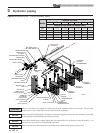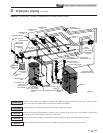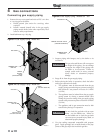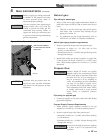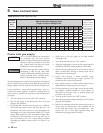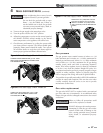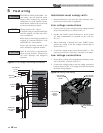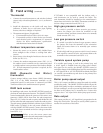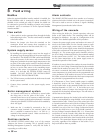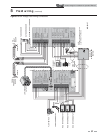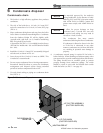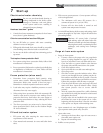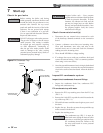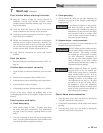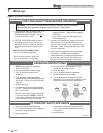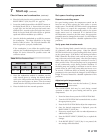
30
Outdoor Knight XL Installation & Operation Manual
5 Field wiring
ModBus
When the optional ModBus interface module is installed, the
RS-485 ModBus cable is connected to these terminals. Use
shielded, 2-wire twisted pair cable. If desired, the shield can
be connected to ground by installing a jumper wire between
terminals 1 and 3 on connector X5 on the optional ModBus
interface module.
Flow switch
1. A fl ow switch is used to guarantee fl ow through the boiler
before allowing it to fi re. The fl ow switch must be installed
at the boiler outlet.
2. Remove the jumper wire from the terminals on the
connection board and connect these terminals to the
normally open contacts on the fl ow switch (FIG. 5-3).
System supply sensor
1. By installing the system supply sensor into the supply of
the primary loop, the temperature of the system supply can
be controlled. The SMART SYSTEM control automatically
detects the presence of this sensor, and controls the boiler
fi ring rate to maintain the system supply temperature to the
set point (if the outlet sensor control is currently selected).
See the Outdoor Knight XL Service Manual for instructions
on how to use the inlet sensor as the controlling sensor.
When the inlet sensor is programmed as the controlling
sensor, it is vital that the SYSTEM SUPPLY sensor be
installed. DO NOT INSTALL THE SYSTEM SUPPLY
SENSOR INTO THE SYSTEM RETURN.
2. The TST2032 sensor provided with the boiler must be used
for the system sensor.
3. Connect these terminals to the system supply sensor
(FIG. 5-3).
Alarm contacts
The SMART SYSTEM control closes another set of contacts
whenever the boiler is locked out or the power is turned off.
This can be used to turn on an alarm, or signal a Building
Management System that the boiler is down.
Wiring of the cascade
When wiring the boilers for Cascade operation, select one
boiler as the Leader boiler. The remaining boilers will be
designated as Members. See page 36 “Confi guration of the
Cascade” for a detailed explanation of this procedure.
Connect the system supply sensor and outdoor air sensor (if
used) to the Leader boiler. For the Cascade system to work
properly the system supply sensor must be installed. The
location of the system supply sensor should be downstream
of the boiler connections in the main system loop (FIG.’s 3-7
through 3-11). The system supply sensor should be wired to
the Low Voltage Connection Board at the terminals marked
for the system sensor (see FIG. 5-3). The Leader control will
use the water temperature at the system supply sensor to
control the operation of the Cascade.
If outdoor air reset is desired, the outdoor air sensor should be
wired to the Low Voltage Connection Board at the terminals
marked for the outdoor air sensor (FIG. 5-3). If the outdoor
air sensor is connected, the Leader control will calculate the
water temperature set point based on the programmed reset
curve parameters. If the outdoor air sensor is not connected,
the Leader control will maintain the fi xed water temperature
set point that is programmed into the control.
If a Thermostat or Zone Control enable output is available,
it should be wired to the Low Voltage Connection Board
on the Leader boiler at the terminals marked for one of the
heat/loop demands 1-3 (FIG. 5-3). If the boilers are to run
continuously, connect a jumper wire between the R and W
terminals for the heat/loop demand input. This will initiate a
call for heat on the Cascade.
Communication between the Leader boiler and the Member
boilers is accomplished by using shielded, 2-wire twisted pair
communication cable. Connect one of the twisted pair wires
to Cascade terminal A on each of the Low Voltage Connection
boards, and the other wire of the twisted pair to Cascade
terminal B on each of the Low Voltage Connection Boards.
Connect the shield wires to one of the shield terminals on
the Low Voltage Connection Boards (FIG. 5-3). If more than
two boilers are on the Cascade, daisy chain the wiring from
the Cascade terminals on the second boiler to the Cascade
terminals on the third boiler, then from the third to the forth,
and so on. The connections between boilers can be made in
any order, regardless of the addresses of the boilers. Try to
keep each cable as short as possible.
Boiler management system
1. An external control may be connected to control either
the fi ring rate or the set point of the boiler. If the
external control uses a set of contacts to enable the boiler,
connect the contacts to the heat/loop demand 1 terminals.
Otherwise, the SMART SYSTEM control will be enabled by
the 0-10V signal.
2. Make sure the (-) terminal is connected to the (-) or
common output terminal of the external control, and
the (+) terminal is connected to the 0 - 10 VDC or (+)
terminal of the external control. Make sure that the (-)
voltage is not below ground.
Runtime contacts
The SMART SYSTEM control closes a set of dry contacts
whenever the burner is running. This is typically used by
Building Management Systems to verify that the boiler is
responding to a call for heat.



